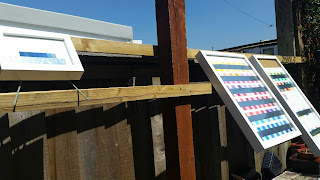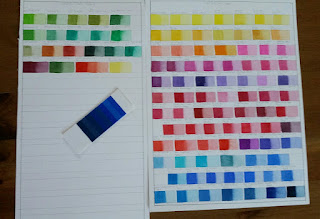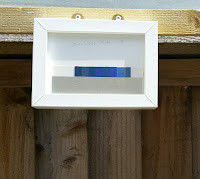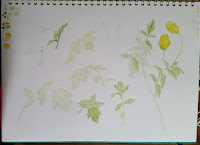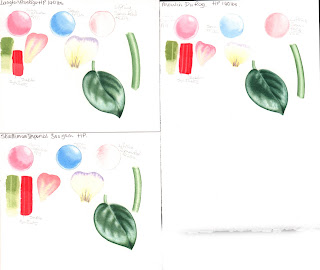 |
| Seeing Triple! |
Prompted by being contacted by several young people, about how to go about painting Botanical subjects in Watercolour, and asking what paints and colours to use, and by the new Young Botanical Artist Competition 2022/3 by the Sherwood Gallery, in collaboration with Royal Botanic Gardens, Kew, I set about checking out the student/enthusiast ranges of well known brands of Watercolour.
I would normally recommend using a small selection of Artists/Professional watercolours, however the price of Artists/Professional quality watercolours has rocketed over the past two years, and while it is still possible to buy some Artist’s/Professional watercolour sets or sample sets at more reasonable prices, if you can find them in a sale, these sets often exclude the colours needed for basic colour mixing, while including colours that aren’t useful if they are your only watercolours.
Especially for Botanical Art, the right yellows, reds and blues can make all the difference to your colour matching and mixing.
However, don’t despair, you can still learn all the important techniques of watercolour and paint Botanical Art with limited funds, and get super results.
One thing you will notice in my Paint-Outs, is that in the Aquafine and Cotman Sets, I have removed the Yellow Ochre and replaced it with Quinacridone Gold. This is because they are my Field Study kits and Quinacridone gold is far more useful to me than Yellow Ochre PY42, which in both cases is Opaque. I didn't use Quinacridone Gold in the Comparison paintings above, nor did I use Yellow Ochre, so it isn't a must-have, but will extend or speed up your colour mixing.
All the Paint-outs were made using exactly the same brush, paper and method, the same number of swipes across each pan and the same number of swipes across the paper for each swatch.
 |
|
Side by Side Comparison of each Set of colours |
Student/Enthusiast brands that are comparable in handling and quality to Artist’s / Professional watercolours in alphabetical order :
 |
|
Akademie Set Colours - No Additions |
Schmincke Akademie – 24 colours - 16 single pigment, 5 double pigment mixes, 3 triple pigment mixes
https://www.schmincke.de/en/produkte/aquarell/akademie-aquarell
Pros - Brilliant colours, the same pigments as found in the Horadam Artist’s watercolour range, finely milled, excellent re-wetting, colours easy to lift from the pan, lovely to work with. All Schmincke Paints are manufactured in Germany.
Cons – can be difficult to find in the UK and often a lot more expensive than the other brands, but this may be different in other countries, smaller colour range (but all the basic colours covered).
---<>---
 |
|
Aquafine 10Pan Travel Set colours + 1 change, + Additions |
Daler Rowney Aquafine - 46 colours (not including metallics) - 27 single pigment, 14 double pigment mixes, 5 triple pigment mixes
https://www.daler-rowney.com/aquafine-watercolour-paint/
Pros - Brilliant colours, many single pigment colours, finely milled, excellent re-wetting, and very easy to lift from the pan, lovely to work with. Most are the same pigments as found in high quality Artist’s/Professional watercolour ranges. Excellent price point and easily available. Sets, tubes and twin half-pan packs easily available. Daler Rowney Paint is manufactured in the UK.
No Chalkiness (I know this has been a problem in the past with this range)
Price – This was the cheapest set to buy, and the replacement pans were also cheapest, they also came in pairs, so you get 2 for the price of one ! You simply need to choose the pair that works best for you. Don't let the price put you off, they still work really well.
Cons - smaller colour range than professional ranges, but all basic colours covered.
---<>---
 |
|
Cotman Sketcher's Box colours + Changes/Additions |
Winsor and Newton Cotman – 40 colours (not including metallics) – 19 single pigment, 16 double pigment mixes, 5 triple pigment mixes
https://www.winsornewton.com/uk/paint/watercolour/cotman-watercolour/
Pros - Good colours, handle well. Sets, Pans and Tubes easily available.
Cons - For me, too many of the basic colours are mixes - eg. yellows/reds. I feel that some of the yellows and reds seem less transparent in use despite being labelled transparent. Smaller colour range, but all basic colours covered. Pans didn't release colour easily as the other brands and it took more work to get the same depth of colour. If you have these, you may wish to pre-wet the pans with a light mist of water.
----------<>----------
Method
I have stayed with the well known brands, for reliability and confidence in their information on light-fastness and transparency/opacity. Information on the pigments used and light-fastness are available on their websites.
In the interests of being thorough, I tested out the three student/enthusiast’s ranges, using their smallest half pan ‘set’ as a base, assessing the usefulness of the colours included and the cost of adding colours to extend the palette to give more range and vibrancy.
To conduct the test, I painted a bright image with a good range of subtle and vibrant colours with each of the sets, along with a black grape to test out the ability to mix deep blacks without using a black pigment, and an unripe blueberry to test out the range of reds and pinks and how they worked with the blues.
I used Daler Rowney Langton Hot Press (Botanical) watercolour paper, which I’ve had for a long time and works well for me. It isn’t cotton paper, however it is 100% wood-free acid-free paper (as is Bockingford). So should last well.
----------<>----------
The Paints used were
 |
| Schmincke Akademie Watercolour Travel Set |
Schmincke Akademie – Set of 10 half pans – * Pigment or mix also used in Artist's ranges.
Suggested additions, Magenta PV42* Cyan*
Orange* instead of English Red. Not a direct swap, but as it's transparent, will give more range for mixing browns.
Quinacridone Gold* instead of Yellow Ochre (whichever one suits you best)
French Ultramarine PB 29*
Carmine PV19*
Cadmium Red Tone PR255*
Indian Yellow PY110,PY154*
Light Lemon PY3*
Permanent Green PO62,PG7*
Prussian Blue PB27*
Sepia PB15.1,PBr7,PBK9*
English Red PR101* (Very Opaque)
Yellow Ochre PY42* (Very Opaque)
----<>----
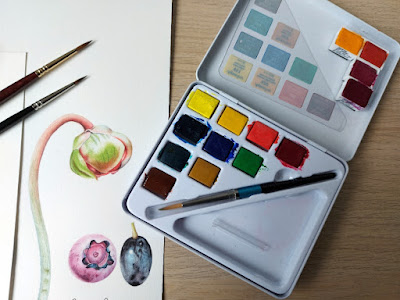 |
|
Daler Rowney Aquafine Watercolour Travel Set |
Daler Rowney Aquafine - Travel Set 10 Half pans + 4 Extra - * used in Artist's ranges
Suggested change - Quinacridone Gold* instead of Yellow Ochre (whichever brand suits you best)
Lemon Yellow PY3*
Cadmium Yellow Hue PY155*
+Indian Yellow Hue PY65* (added to extend the range of yellows)
+Cadmium Orange Hue PO71* (Added because it came with the Indian Yellow!)
Vermilion Hue PR255*
Alizarin Crimson PR176*
+Quinacridone Magenta PR122* (added for a Pink option)
+Purple Lake PV19* (added because it came with the Q.Magenta!)
Prussian Blue PB27*
Ultramarine PB29*
Leaf Green PY3,PG7*
Viridian Hue PG7*
Quinacridone Gold* (replaces Yellow Ochre PY42 which is fiercely opaque)
Burnt Sienna PR101*
----<>----
 |
|
W&N Cotman Watercolour Sketcher's Pocket Set |
W&N Cotman watercolours – Sketchers Pocket Box - set of 12 half pans – * used in Artist's ranges
Suggested change - Quinacridone Gold* instead of Yellow Ochre (whichever brand suits you best)
Lemon Yellow Hue PY175* (replaced the Cad Yellow Pale Hue which wasn’t transparent)
Cadmium Yellow Hue PY197, PY65
Cadmium Red Pale Hue PR255, PY65
Alizarin Crimson Hue PRN/A, PR206*
+Permanent Rose PV19* (Replaced Chinese White which I have no use for)
Ultramarine PB29*
+Intense Blue (Phthalo Blue) PB15* (Replaced Cobalt Blue Hue – a mix and not different enough to Ultramarine. Sketcher's box now seems to contain Cerulean Hue)
Viridian Hue PG7*
Sap Green PY139,PG36,PR101
+Q. Gold* (replaces Yellow Ochre PY42 which is fiercely opaque)
Burnt Sienna PR101*
Burnt Umber PBr7, PY42
CONCLUSION
While I have my own preferences regarding which of these sets works best for me, any of them would be a good starting place for someone with serious intent and not a lot of money to spare, who may be daunted by using the expensive paints they've bought, or are reluctant to 'waste' expensive paints at the beginning of their journey. The lower price means that essential play, experimentation and practise, as well as more
serious paintings, are possible without fear of incurring high costs in
replacements, or fear of 'wasting the good paints'. The whole point of these paints is that they will give excellent results while building confidence.
They also allow upgrading to professional grade paints in the future, as and when each colour runs out, but with no urgency to do so.
So there you have it. Student/Enthusiast Watercolour quality of the best known Paint Manufacturers has come a long way in the last decade. There are slight differences between these paints and the Artist's ranges, but this shouldn't put you off if you are just starting out on your watercolour journey, or the cost of buying/replacing watercolours is a challenge for you.







